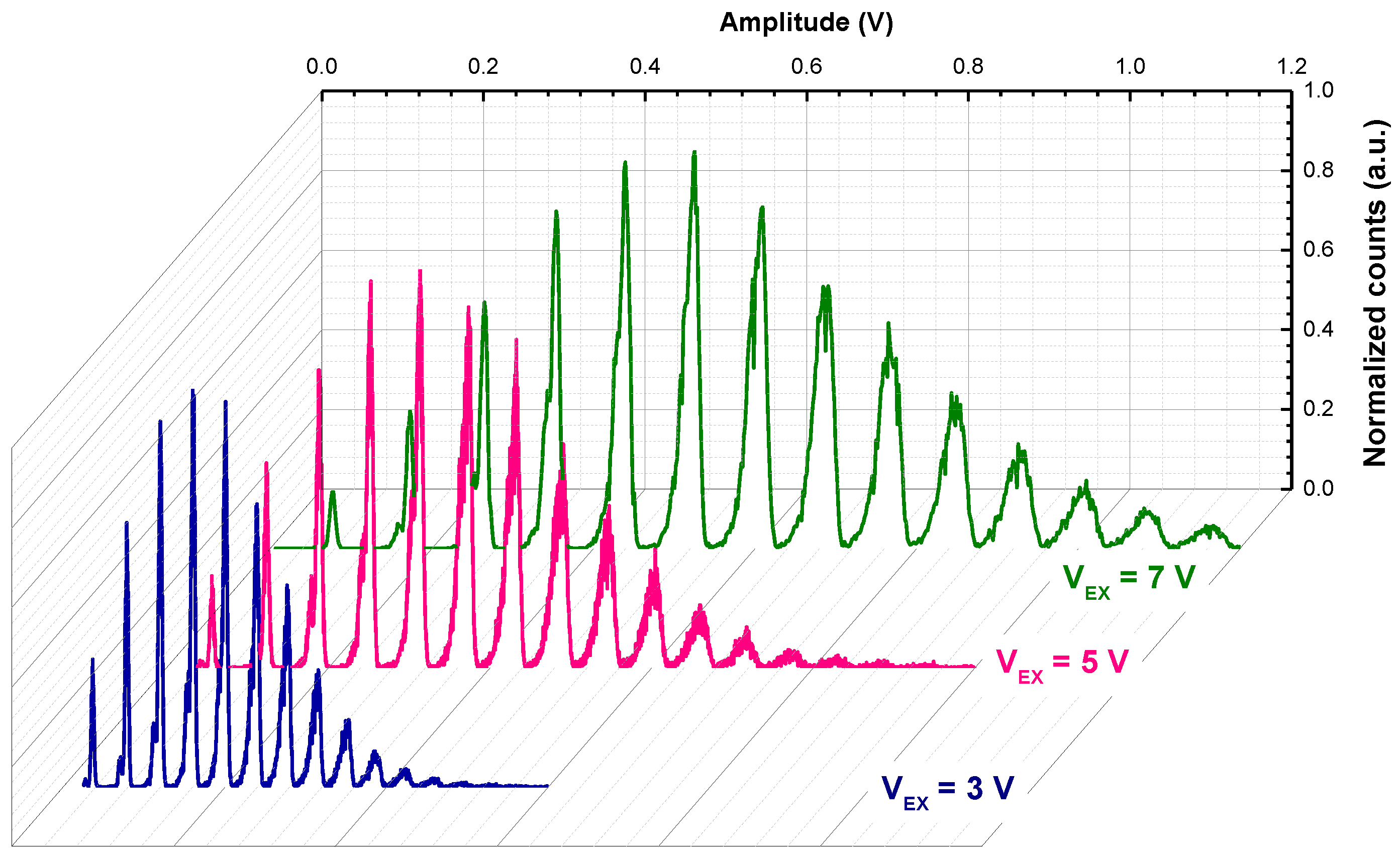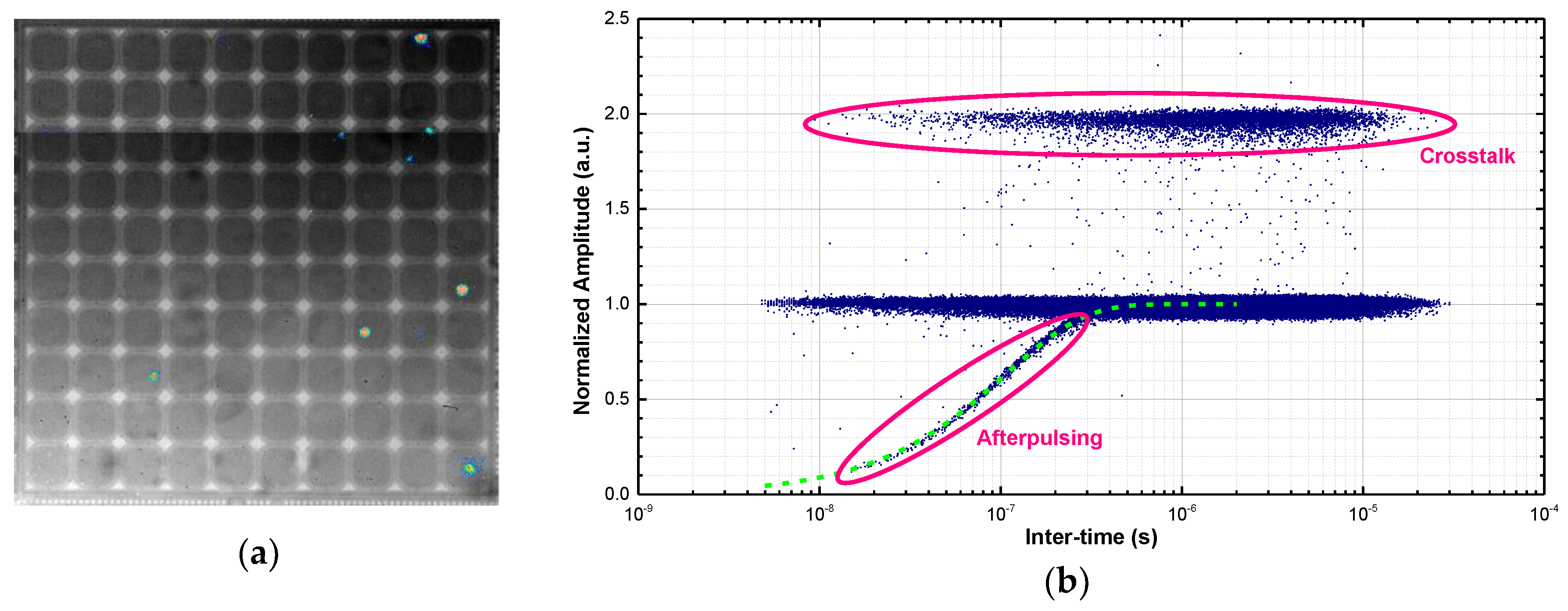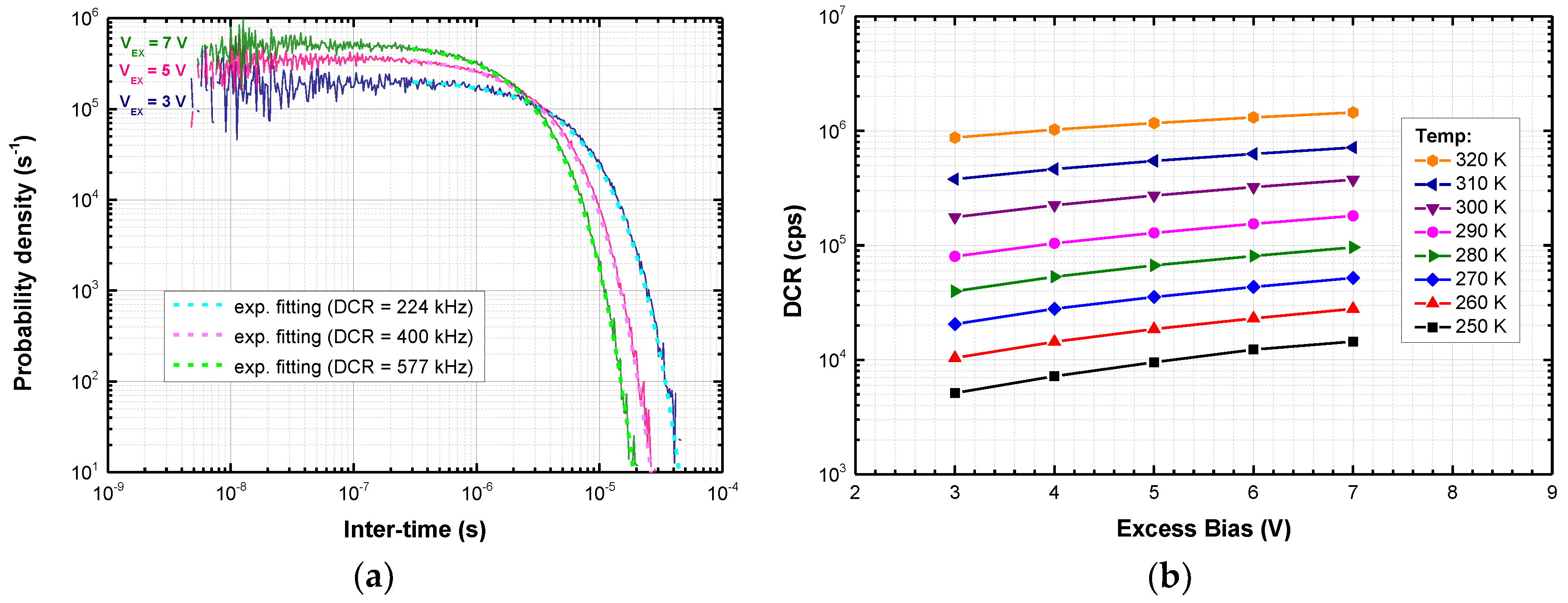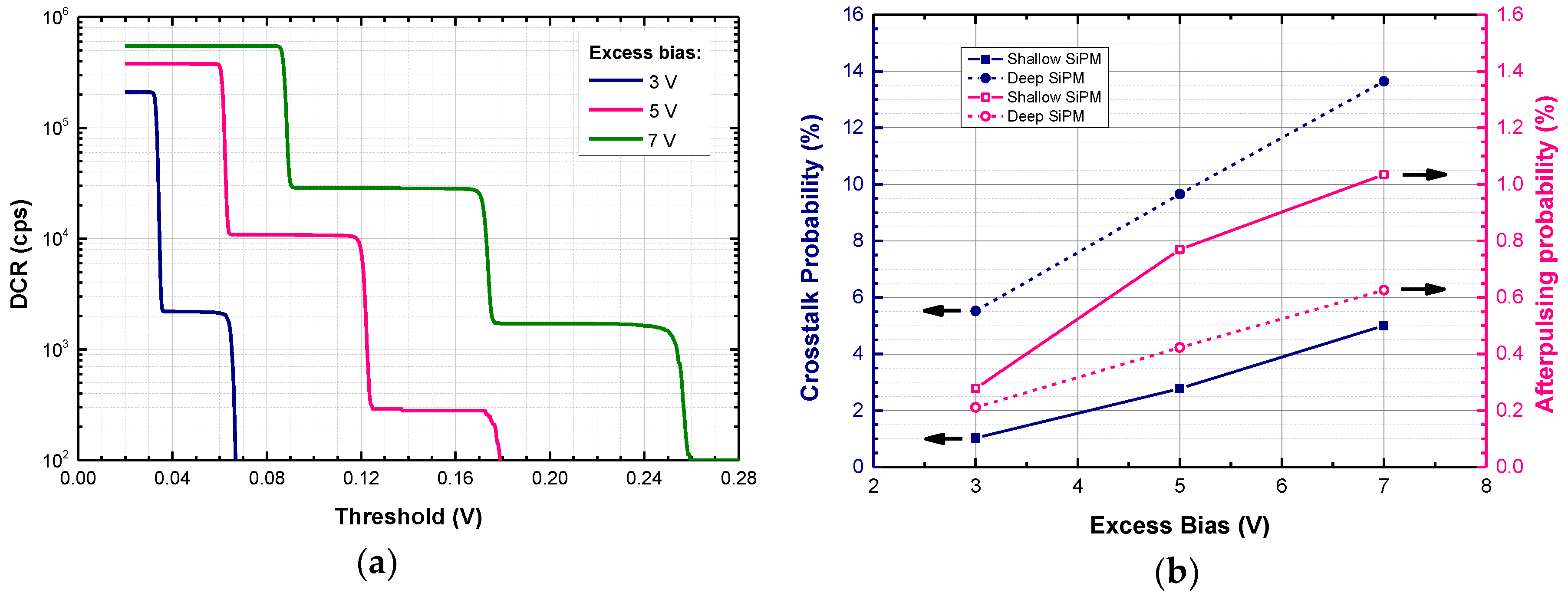0.16 µm–BCD Silicon Photomultipliers with Sharp Timing Response and Reduced Correlated Noise
Abstract
:1. Introduction
2. Materials and Methods
3. Results
3.1. Pulse Amplitude Spectrum
3.2. Photon Detection Efficiency
3.3. Noise Characterization
- ‘primary’ dark counts are events with unitary amplitude;
- events with double amplitude are crosstalk events triggered by a dark count;
- afterpulses occur at short inter-times (< 300 ns in our case) and their amplitude follows the exponential recovery of the microcell.
3.4. Timing Response
4. Discussion and Conclusions
Author Contributions
Funding
Conflicts of Interest
References
- Zappa, F.; Tisa, S.; Tosi, A.; Cova, S. Principles and features of single-photon avalanche diode arrays. Sens. Actuators A Phys. 2007, 140, 103–112. [Google Scholar] [CrossRef]
- Eckert, P.; Schultz-Coulon, H.; Shen, W.; Stamen, R.; Tadday, A. Characterization studies of silicon photomultipliers. Nucl. Instrum. Methods Phys. Res. Sect. A Accel. Spectrom. Detect. Assoc. Equip. 2010, 620, 217–226. [Google Scholar] [CrossRef]
- Aalseth, C.E.; Acerbi, F.; Agnes, P.; Albuquerque, I.F.M.; Alexander, T.; Alici, A.; Alton, A.K.; Antonioli, P.; Arcelli, S.; Ardito, R.; et al. DarkSide-20k: A 20 Tonne Two-Phase LAr TPC for Direct Dark Matter Detection at LNGS. Eur. Phys. J. Plus 2018, 133, 131. [Google Scholar] [CrossRef]
- Moses, W.W. Recent Advances and Future Advances in Time-of-Flight PET. Nucl. Instrum. Methods Phys. Res. A 2007, 580, 919–924. [Google Scholar] [CrossRef] [PubMed]
- Mora, A.D.; Martinenghi, E.; Contini, D.; Tosi, A.; Boso, G.; Durduran, T.; Arridge, S.; Martelli, F.; Farina, A.; Torricelli, A.; et al. Fast Silicon Photomultiplier Improves Signal Harvesting and Reduces Complexity in Time-Domain Diffuse Optics. Opt. Express 2015, 23, 13937. [Google Scholar] [CrossRef] [PubMed]
- Son, K.T.; Lee, C.C. Multiple-Target Laser Rangefinding Receiver Using a Silicon Photomultiplier Array. IEEE Trans. Instrum. Meas. 2010, 59, 3005–3011. [Google Scholar] [CrossRef]
- Zou, Y.; Villa, F.; Bronzi, D.; Tisa, S.; Tosi, A.; Zappa, F. Planar CMOS Analog SiPMs: Design, Modeling, and Characterization. J. Mod. Opt. 2015, 62, 1693–1702. [Google Scholar] [CrossRef] [Green Version]
- D’Ascenzo, N.; Zhang, X.; Xie, Q. Application of CMOS Technology to Silicon Photomultiplier Sensors. Sensors 2017, 17, 2204. [Google Scholar] [CrossRef] [PubMed]
- Schaart, D.R.; Charbon, E.; Frach, T.; Schulz, V. Advances in Digital SiPMs and Their Application in Biomedical Imaging. Nucl. Instrum. Methods Phys. Res. Sect. A Accel. Spectrom. Detect. Assoc. Equip. 2016, 809, 31–52. [Google Scholar] [CrossRef]
- Sanzaro, M.; Gattari, P.; Villa, F.; Tosi, A.; Croce, G.; Zappa, F. Single-Photon Avalanche Diodes in a 0.16 µm BCD Technology with Sharp Timing Response and Red-Enhanced Sensitivity. IEEE J. Sel. Top. Quantum Electron. 2018, 24, 1–9. [Google Scholar] [CrossRef]
- Seifert, S.; van Dam, H.T.; Huizenga, J.; Vinke, R.; Dendooven, P.; Lohner, H.; Schaart, D.R. Simulation of Silicon Photomultiplier Signals. IEEE Trans. Nucl. Sci. 2009, 56, 3726–3733. [Google Scholar] [CrossRef] [Green Version]
- Acerbi, F.; Cazzanelli, M.; Ferri, A.; Gola, A.; Pavesi, L.; Zorzi, N.; Piemonte, C. High Detection Efficiency and Time Resolution Integrated-Passive-Quenched Single-Photon Avalanche Diodes. IEEE J. Sel. Top. Quantum Electron. 2014, 20, 268–275. [Google Scholar] [CrossRef]
- Acerbi, F.; Ferri, A.; Zappala, G.; Paternoster, G.; Picciotto, A.; Gola, A.; Zorzi, N.; Piemonte, C. NUV Silicon Photomultipliers with High Detection Efficiency and Reduced Delayed Correlated-Noise. IEEE Trans. Nucl. Sci. 2015, 62, 1318–1325. [Google Scholar] [CrossRef]
- Oldham, W.G.; Samuelson, R.R.; Antognetti, P. Triggering Phenomena in Avalanche Diodes. IEEE Trans. Electron Devices 1972, 19, 1056–1060. [Google Scholar] [CrossRef]
- Piemonte, C.; Ferri, A.; Gola, A.; Picciotto, A.; Pro, T.; Serra, N.; Tarolli, A.; Zorzi, N. Development of an Automatic Procedure for the Characterization of Silicon Photomultipliers. In Proceedings of the 2012 IEEE Nuclear Science Symposium and Medical Imaging Conference Record (NSS/MIC), Anaheim, CA, USA, 27 October–3 November 2012; pp. 428–432. [Google Scholar] [CrossRef]
- Hamamatsu MPPC Technical Note. Available online: https://www.hamamatsu.com/resources/pdf/ssd/mppc_kapd9005e.pdf (accessed on 28 August 2018).
- Lacaita, A.; Ghioni, M.; Cova, S. Double Epitaxy Improves Single-Photon Avalanche Diode Performance. Electron. Lett. 1989, 25, 841. [Google Scholar] [CrossRef]
- Rech, I.; Ingargiola, A.; Spinelli, R.; Labanca, I.; Marangoni, S.; Ghioni, M.; Cova, S. Optical Crosstalk in Single Photon Avalanche Diode Arrays: A New Complete Model. Opt. Express 2008, 16, 8381. [Google Scholar] [CrossRef] [PubMed]
- Renna, M.; Buttafava, M.; Zappa, F.; Tosi, A.; Martinenghi, E.; Zanoletti, M.; Mora, A.D.; Pifferi, A.; Torricelli, A.; Contini, D. Compact Dual-Wavelength System for Time-Resolved Diffuse Optical Spectroscopy. In Proceedings of the 2017 13th Conference on Ph.D. Research in Microelectronics and Electronics (PRIME), Giardini Naxos, Italy, 12–15 June 2017; pp. 293–296. [Google Scholar] [CrossRef]
- SensL C-Series Datasheet. Available online: http://sensl.com/downloads/ds/DS-MicroCseries.pdf (accessed on 29 August 2018).
- Hamamatsu S13360 Series Datasheet. Available online: https://www.hamamatsu.com/resources/pdf/ssd/s13360_series_kapd1052e.pdf (accessed on 29 August 2018).
- AdvanSiD RGB SiPMs Datasheet. Available online: http://advansid.com/attachment/get/up_55_1433423956.pdf (accessed on 29 August 2018).
- Excelitas C30742-11 Series Datasheet. Available online: http://www.excelitas.com/Downloads/DTS_C30742-11-050_Series_SiPM.pdf (accessed on 29 August 2018).
- Broadcom AFBR-S4N44C013 Datasheet. Available online: https://www.broadcom.com/products/optical-sensors/silicon-photomultiplier-sipm/afbr-s4n44c013 (accessed on 21 October 2018).
- Ketek WB Series Device Parameters. Available online: https://www.ketek.net/sipm/sipm-products/wb-series/ (accessed on 21 October 2018).
- Acerbi, F.; Ferri, A.; Gola, A.; Cazzanelli, M.; Pavesi, L.; Zorzi, N.; Piemonte, C. Characterization of Single-Photon Time Resolution: From Single SPAD to Silicon Photomultiplier. IEEE Trans. Nucl. Sci. 2014, 61, 2678–2686. [Google Scholar] [CrossRef]
- Schwinger, A.; Brockherde, W.; Hosticka, B.J.; Vogt, H. CMOS SiPM with Integrated Amplifier. In Proceedings of the 2017 SPIE OPTO, Optical Components and Materials XIV, San Francisco, CA, USA, 28 January–2 February 2017; p. 101001. [Google Scholar]







| Device | Cells | FF (%) | Peak PDE (%) | DCR/area (kHz/mm 2) | Crosstalk (%) | Timing Jitter (ps) |
|---|---|---|---|---|---|---|
| SensL C-Series [20] | 282 | 72 | 35 1 | 30 1 | 10 1 | NA |
| Hamamatsu S13360 [21] | 667 | 74 | 40 2 | 53 2 | 3 2 | NA |
| AdvanSiD ASD-RGB1S [22] | 625 | 60 | 32.5 3 | < 100 4 | 32 3 | NA |
| Excelitas C30742-11 [23] | 400 | NA | 33 5 | 150 5,6 | NA | NA |
| Broadocom AFBR-S4N44C013 [24] | 15,060 | 76 | 54 7 | 170 7 | 27 7 | NA |
| Ketek PM11 Series [25] | 1600 | NA | 43 8 | 100 8 | 20 8 | 230 8 |
| 0.35 µm CMOS SiPM [7] | 256 | 73.7 | 34 9 | 584 9 | 33.5 9 | 240–340 |
| 0.18 µm BCD SiPM [8] | 400 | NA | 1.3 | 20000 | 40 | NA |
| BCD Shallow SiPM (this work) | 100 | 53 | 23 10 | 890 10 | 2.8 10 | 78 |
| BCD Deep SiPM (this work) | 100 | 53 | 33 10 | 732 10 | 9.7 10 | 81 |
© 2018 by the authors. Licensee MDPI, Basel, Switzerland. This article is an open access article distributed under the terms and conditions of the Creative Commons Attribution (CC BY) license (http://creativecommons.org/licenses/by/4.0/).
Share and Cite
Sanzaro, M.; Signorelli, F.; Gattari, P.; Tosi, A.; Zappa, F. 0.16 µm–BCD Silicon Photomultipliers with Sharp Timing Response and Reduced Correlated Noise. Sensors 2018, 18, 3763. https://doi.org/10.3390/s18113763
Sanzaro M, Signorelli F, Gattari P, Tosi A, Zappa F. 0.16 µm–BCD Silicon Photomultipliers with Sharp Timing Response and Reduced Correlated Noise. Sensors. 2018; 18(11):3763. https://doi.org/10.3390/s18113763
Chicago/Turabian StyleSanzaro, Mirko, Fabio Signorelli, Paolo Gattari, Alberto Tosi, and Franco Zappa. 2018. "0.16 µm–BCD Silicon Photomultipliers with Sharp Timing Response and Reduced Correlated Noise" Sensors 18, no. 11: 3763. https://doi.org/10.3390/s18113763





